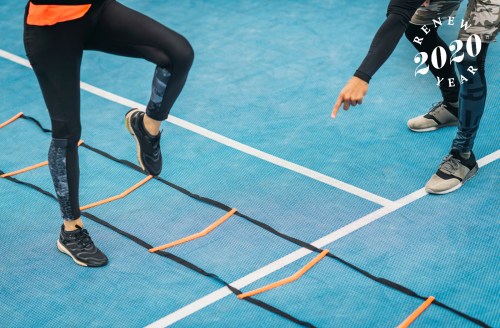Our editors independently select these products. Making a purchase through our links may earn Well+Good a commission
6 Agility Exercises That’ll Boost Your Speed (and Strength) in Workouts
Trainers explain how agility skills can benefit everyone's fitness routine, plus the best agility exercises for you to try for yourself.

A formula for a good fitness routine includes cardio, strength, endurance, and power. We tend to think a lot about the first two, but if you add agility into the mix, you’ll be even stronger (and faster) in the given workout you’re trying to perform. The benefits of agility go beyond an intense workout. For starters, it can help improve your mind-body connection, it can improve your force production and natural reflexes, and because more muscles are recruited when doing things like cone drills, it will help define your muscles quicker than say a more stationary exercise.
“When you think of agility, you may conjure images of top athletes with cat-like reflexes,” says Corey Phelps, a Washington, D.C.-based fitness trainer. But you don’t have to be a pro athlete to benefit from agility exercises, because having these skills will improve your coordination, which is key in any training regimen. “The benefits range from better balance and flexibility to the ability to control and maintain good posture and alignment,” says Steve Stonehouse, trainer and director of education for Stride. Agility is your body’s ability to be “quick and nimble while maintaining control,” says Phelps.
Agility training can have everyday benefits too: “Think of how important it is to be able to pivot and change directions quickly, like if you go to cross the street and have to dodge a big pothole without falling, or moving swiftly to catch your brand-new iPhone before it hits the floor,” says Phelps. Those quick reflexes come in handy IRL, which is all the more reason to add some agility drills to your sweat sesh. Keep scrolling for trainers’ go-to agility exercises to try for yourself.
Agility exercises
1. Plyometric box jumps:
This is a fave of both Phelps and Stonehouse. Find a sturdy box of a challenging but manageable height, from around three to four feet tall. With your feet hip-width apart, bend your knees slightly and drive through your heels as you jump on top of the box, landing softly in a squat with both feet flat on the box. Perform for 30- to 60-second intervals.
2. Shuttle runs:
Grab some cones or markers and set them 25 meters apart. Sprint from one marker to the other and back for one rep, says Phelps, who recommends six repetitions as fast as you can, then rest and repeat.
3. Speed ladder work:
Ladder work is great for anyone looking to improve their reaction time and coordination. From football to boxing the benefits are endless. Lay down an agility ladder ($14) and challenge your agility by stepping in and out of each box in different patterns as fast as you can, says Stonehouse. For beginners, try doing quick feet in each square (place your left and right foot down once in each square). From there, you can progress to more difficult ladder drills like the Ali Shuffle.
4. Wicket runs:
If you want to improve your sprint mechanics and force production, try wicket runs. All you need is a set of mini hurdles ($30). There are a variety of ways to space out the hurdles, so we recommend working with a trainer or watching the above video to figure out the best spacing. Once you’re set-up, sprint as fast as you can over the hurdles without knocking them over.
5. Jump rope:
While traditional jump roping is a good challenge, Stonehouse suggests mixing it up by jumping one foot at a time or alternating your feet forwards and backward for more agility work. As you get acclimated with jumping rope, try more advanced options like double-unders.
6. Lateral plyometric jumps:
With your feet no more than hip-width apart, bend your knees to squat and push through your heels, pushing upwards and sideways towards the other side of the room. Phelps says to land softly and absorb the shock by squatting deeply. Perform for 30- to 60-second intervals.
Try this dynamic warmup before you get started to get your blood pumping:
Oh hi! You look like someone who loves free workouts, discounts for cult-fave wellness brands, and exclusive Well+Good content. Sign up for Well+, our online community of wellness insiders, and unlock your rewards instantly.










